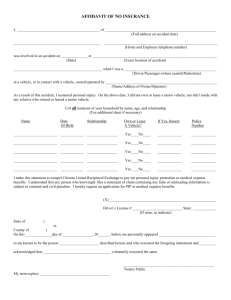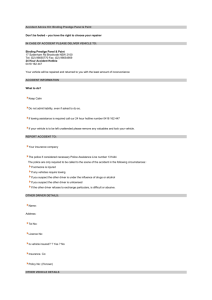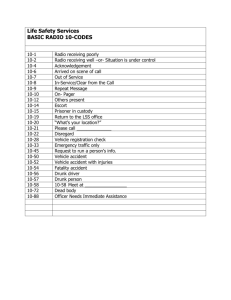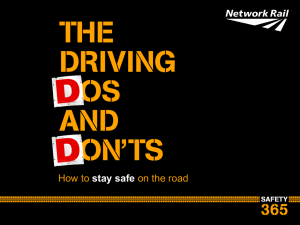Study Guide for Chapter 1 Lesson 3 The Risks of Driving
advertisement
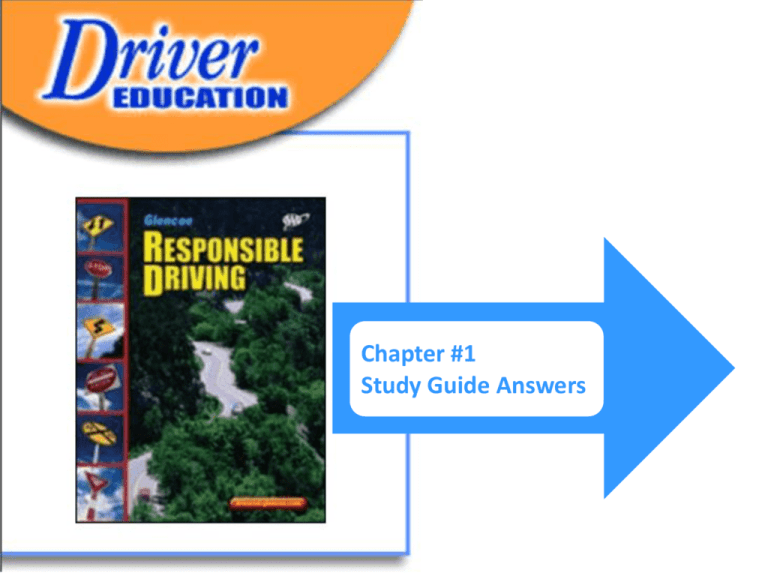
Chapter #1 Study Guide Answers CHAPTER 1 Driving and Mobility STUDY GUIDE FOR CHAPTER 1 LESSON 1 Mobility and Driver Education A. Driver education courses have many great benefits. What do you think the results would be in the long run, say in 20 years, on the following rates and statistics if there were no driver education courses? 1. Insurance rates would increase greatly because of more crashes. This would make insurance too expensive for the average young person to purchase. 2. Accident rates would increase greatly, especially for newer, younger drivers 3. Drinking and driving conviction rates would probably rise, especially for younger drivers, who might not learn about the reasons not to drink and drive. 4. Traffic deaths would increase greatly, especially for younger drivers. B. Describe briefly your personality as you think it will affect your driving. 1. What is your maturity level? 2. Do you get upset easily? 3. What kind of situations annoy you? C. FIND OUT MORE. Speak to a parent about car insurance and look online. 1. What type of insurance does your family use? 2. Will you be added to the policy or will you be getting your own insurance? 3. What will the insurance rates will be for you when you are ready to drive? New drivers are usually between $1200 - $2500 for 1 year. 4. What will qualify you for a good student discount? 30 hr certificate, A or B in DE class, over 3.0 GPA or higher with transcript. Look online http://www.state.nj.us/mvc/Vehicle/InsuranceRequirements.htm 5. What type of vehicle insurance is mandatory in New Jersey? Liability, PIP, Uninsured Motorist New Jersey Insurance All vehicles registered in New Jersey require three types of mandatory insurance: • Liability insurance pays others for damages that you cause if you are responsible for an accident. It does not cover medical expenses • Personal injury protection (PIP) pays medical expenses if you or other persons covered under your policy are injured in an automobile accident. Often called No Fault coverage, it pays your medical expenses if you were or were not at fault • Uninsured motorist coverage protects you if you are in an accident with someone who doesn’t have proper insurance coverage STUDY GUIDE FOR CHAPTER 1 LESSON 2 The Highway Transportation System A. The National Highway Safety Act controls the regulations for vehicle registration, road construction and maintenance, and driver licensing. What do you think the effects on the following would be if suddenly we had no National Highway Safety Act? Roads and Highways: Inconsistent, possibly unsafe road construction and maintenance from state to state. Drivers and Pedestrians: Dangerous conditions at intersections and on roads due to different laws from state to state. Cars and Trucks: With different inspection standards from state to state, or no standards in some states, increased pollution and higher accident rates could occur. B. Although each state has its own laws governing the use of motor vehicles, the federal government has also set national highway and driving standards. Tell by marking S or F next to the provision whether it is a state or federal law. 1. F 2. 3. Sets national standards for all motor vehicle equipment. F 4. 5. 6. 7. 8. Regulates vehicle inspection. Enforces traffic laws. S S F 9. 10. Establishes the maximum speed that may be driven anywhere. Tells what highway maintenance the state must provide. Regulates vehicle registration. Instructs automobile manufacturers about what safety devices they must provide. Assigns points to driver’s record for traffic violations. Regulates driver licensing. S F S Requires the vehicle manufacturer to recall a vehicle and correct any defects discovered after a vehicle is sold. C. FIND OUT MORE. Interview somebody you know who is a driver. 1. Ask that person what he or she does personally to reduce risk when driving. 2. What does the driver do to keep the vehicle in good, safe condition? 3. What does he or she do to anticipate the actions of others? 4. Do the driver and all passengers wear seatbelts? 5. Has the driver ever driven while very tired or sick? 6. What has the driver done in the last year to improve his or her driving skills? Study Guide for Chapter 1 Lesson 3 The Risks of Driving A. For each sentence below, circle T if the statement is true and F if it is false. Correct each false statement in the space provided below. 1. Driving does not involve risk. False - Driving involves risk. There is a possibility of personal injury or damage to vehicles and property. 2. In any given year, the likelihood of your being involved in a crash is 1 in 9. True 3. Driving involves risk even for experienced drivers. True 4. When you are driving, increasing your visibility also increases risk. False - Increasing visibility decreases risk. 5. The foundations of effective driving include searching and giving meaning, understanding options and choices, and mastering basic driving skills. True B. In the space below, name the five steps you can take to reduce risk while driving. Keep your vehicle in top condition Anticipate the actions of others Protect yourself and others Drive only when you’re in sound physical and mental condition Make a conscious effort to develop your driving skills

